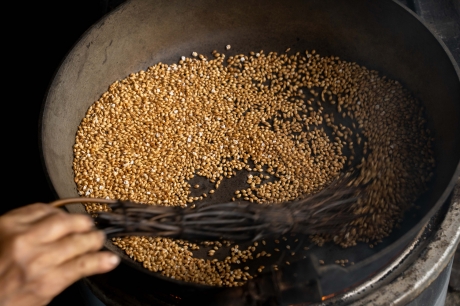
Growing millets and other indigenous crops on these steep slopes is no small feat. However, farmers designed a unique method for using grass to stop soil erosion. ©Tokushima-Mt. Tsurugi GIAHS Promotion Association
In the mountainous Tokushima region of Japan, farmers have grown local varieties of millet, vegetables and other crops for more than 400 years. But in recent times, the cultivation of millets, a highly nutritious crop, almost died out. Only the love of a farmer in Nishi-Awa helped save a local variety of finger millet from vanishing completely.
In post-war Japan increasing prosperity brought a marked preference for rice, while millet became a symbol of poverty. Consequently, people gradually stopped cropping millets. One local farmer remarked, “When I ate finger millet in primary school, I felt some shame because it meant a lack of rice.”
Nonetheless, in 2018, when the Nishi-Awa Steep Slope Land Agriculture System became recognized as a Globally Important Agricultural Heritage System (GIAHS) by the Food and Agriculture Organization of the United Nations (FAO), people quickly realized that local varieties of millet were an important genetic and cultural resource and that they are a type of crop that is highly adaptable to climate change.

The Nishi-Awa site is remarkable because, on extremely steep slopes (up to 40 degrees) normally deemed unsuitable for agriculture, farmers derived an innovative way of cultivating indigenous varieties of crops including, buckwheat, tubers and different types of millets, without converting the land into terraced fields. Instead, grasslands are established around the sloping fields mainly for the purpose of providing kaya, a type of grass to lay over the soil or to use as mulch and prevent soil erosion.
After millets got more attention thanks to the Nishi Awa site, the Iya Millet Production Association was organized to promote local varieties of this important crop. However, by 2018, it was difficult to find millet farmers in the area.
This was particularly unfortunate because crops like millet cannot reproduce without human intervention. Seeds of local varieties of finger millet, Japanese millet, foxtail millet, common millet and sorghum cannot be stored more than four years without a substantial decrease in the germination rate. In other words, to stay alive, the local millet varieties needed to be cropped continuously, generation by generation.

Only one elderly couple in the Higashi-iya village was still cropping the local variety of finger millet for their own consumption. The wife adored the nostalgic taste of the finger millet, and her husband continued to grow it out of his love for her. However, by 2018, even this elderly couple found that single-handedly cultivating this millet crop had become challenging.
The Iya Millet Production Association thus inherited the couple’s finger millet seeds and is now continuously cropping this variety at the Nishi Awa site. The Association is also currently working with cultural anthropologists at Tokushima University to develop new millet commodities such as biscuits, pancakes and sweets.
In 2021, Slow Food International registered six varieties of Iya millet as part of their Ark of Taste initiative to support their preservation. Though millet is still not a staple food in Japan today, people appreciate it for its flavour, health benefits and local origin. Rediscovering abandoned millet varieties is becoming a new source of income for local people.
The United Nations officially designated 2023 as the International Year of Millets to raise awareness of their nutritional and health benefits and their suitability for cultivation under adverse and changing climatic conditions. The hope is that more and more farmers and consumers will uncover the unique taste and exceptional traits of this underestimated crop.
As finger millet spreads back to the fields of Japan, it is because of a love story that this important crop endured and is alive again in the region.
Source: the FAO News and Media office, Rome
– global bihari bureau





